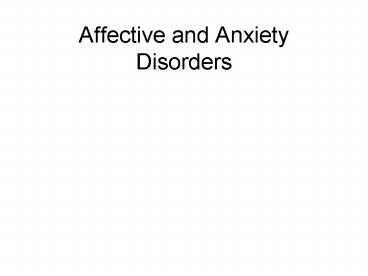Affective and Anxiety Disorders - PowerPoint PPT Presentation
Title:
Affective and Anxiety Disorders
Description:
Affective and Anxiety Disorders ... – PowerPoint PPT presentation
Number of Views:74
Avg rating:3.0/5.0
Title: Affective and Anxiety Disorders
1
Affective and Anxiety Disorders
2
What are affective disorders?
- Disorders of mood
- found throughout history
- unipolar or major depression
- bipolar or manic depression
3
Depression
- Depression
- over 10 with 5 (11,000,000) suffering from a
depressive episode in any given year - untreated - 25 - 30 will attempt or commit
suicide - 2X greater prevalence in women than men
- estimated only 50 receive specific treatment
4
Characteristics of Depression
5
Biological Factors Influencing liklihood of
depression
- Genetics
- concordance rates
- fraternal twins - 20 concordance
- monozygotic or identical twins - 50 concordance
6
- Neurochemical Theory
- monoamine theory
- supportive data
- 1. Reserpine makes synaptic vesicles leak NT
- 2. Drugs used to treat depression increase
activity of NE and/or 5HT neurons
7
How do we treat depression?
- Pharmacologically
- drugs have been available for 40 years
- two categories of drugs emerged about the same
time tricyclic antidepressants and MAO
inhibitors - more recently SSRIs have taken over the market
8
So how do these antidepressants work?
9
Tricyclic antidepressants
- Blocks reuptake of NE and 5HT
- very widely used
- fairly significant side effects
- mainly because they block ACh receptors
- blurred vision, dry mouth, urinary retention,
irregular heart rate, constipation, sexual
dysfunction, - effects on other NT
- sedation, weight gain
10
SSRIs
- Fluoxetine (Prozac) - first introduced in US in
1988 - SSRIs have a more favorable side effect profile
than earlier antidepressants - relatively safe (esp in OD situations)
- some controversy... increased risk of suicide
especially in kids
11
(Celexa)
12
How do SSRIs work?
- Block reuptake of 5HT
- selective serotonin reuptake inhibitor
13
MAO inhibitors
- definitely not first line for treatment
- MAO- enzyme that breaks down excess DA, NE, 5HT
so MAO inhibitors result in increased DA, NE and
5HT
14
Limitations of MAO inhibitors
- can cause significant interaction when people
consume certain foods - consequence potentially hypertensive crisis
could be stroke - Alters the metabolism of an amino acid that fools
sympathetic nervous system into getting
overstimulated
15
Limitations of MAO inhibitors
- Alters the metabolism of amino acid tyramine
- foods high in tyramine include aged cheeses,
wine, smoked fish, yeast products
16
Limitations of MAO inhibitors
- consumption of these can result in a hypertensive
crisis - severe headaches, heart palpitations. Flushing,
nausea, vomiting, stroke - very long ½ life (drugs stay in body for at least
a couple of weeks) - There are now some MAO inhibitors that clear the
body more quickly but still these are never the
first drugs considered
17
Current problems that still exist with
pharmacotherapy of depression
- Some patients do not respond well to first
treatment - most take 3 - 4 weeks to exert significant
therapeutic effects
18
How is this explained in terms of NT activity?
- NT activity is changed very quickly with
psychotropics - Most believe it is more related to change in
number or sensitivity of postsynaptic receptors
(down or up regulation)
19
Current problems that still exist with
pharmacotherapy of depression
- Amount of time needed to see therapeutic effect
(already discussed) - Some patients do not respond well to first
treatment
20
Three alternatives to drug treatment
- 1. ECT - electroconvulsive therapy
- may cause the most rapid change in receptor
density - 2. Sleep deprivation
- many sleep abnormalities associated with
endogenous depression - reduced SWS, increased stage 1, increased REM
21
- 3. Phototherapy - Seasonal Affective Disorder
- 92 survey responders noticed seasonal change
in mood - 27 claim it causes them problems
- 4 diagnosed with SAD
22
Bipolar
- 1 incidence (lower than depression)
- symptoms usually emerge during adolescence or
early adulthood - no sex differences in incidence
- without effective treatment - 20 result in
suicide
23
Bipolar disorder
- Treatments
- oldest - lithium
- odd history-
- lithium metal isolated in early 1800s
- 1940s - replaced sodium chloride with lithium
chloride for hypertensive patients - reintroduced to treat bipolar in 1970
24
Bipolar disorder
- Treatments
- oldest - lithium
- odd history-
- lithium metal isolated in early 1800s
- 1940s - replaced sodium chloride with lithium
chloride for hypertensive patients - reintroduced to treat bipolar in 1970
- limitations of lithium
- effective dose and toxic dose are TOO close
- regular blood monitoring
25
Newer treatments
- newer anticonvulsants
- Anticonvulsants MUCH SAFER THAN LITHIUM!!!
- carbamazepine (Tegretol) or valproic acid
(Divalproex) - Potential issue recent study showed that the
anticonvulsants may improve symptoms but are not
as effective as lithium at reducing suicides and
suicide attempts































